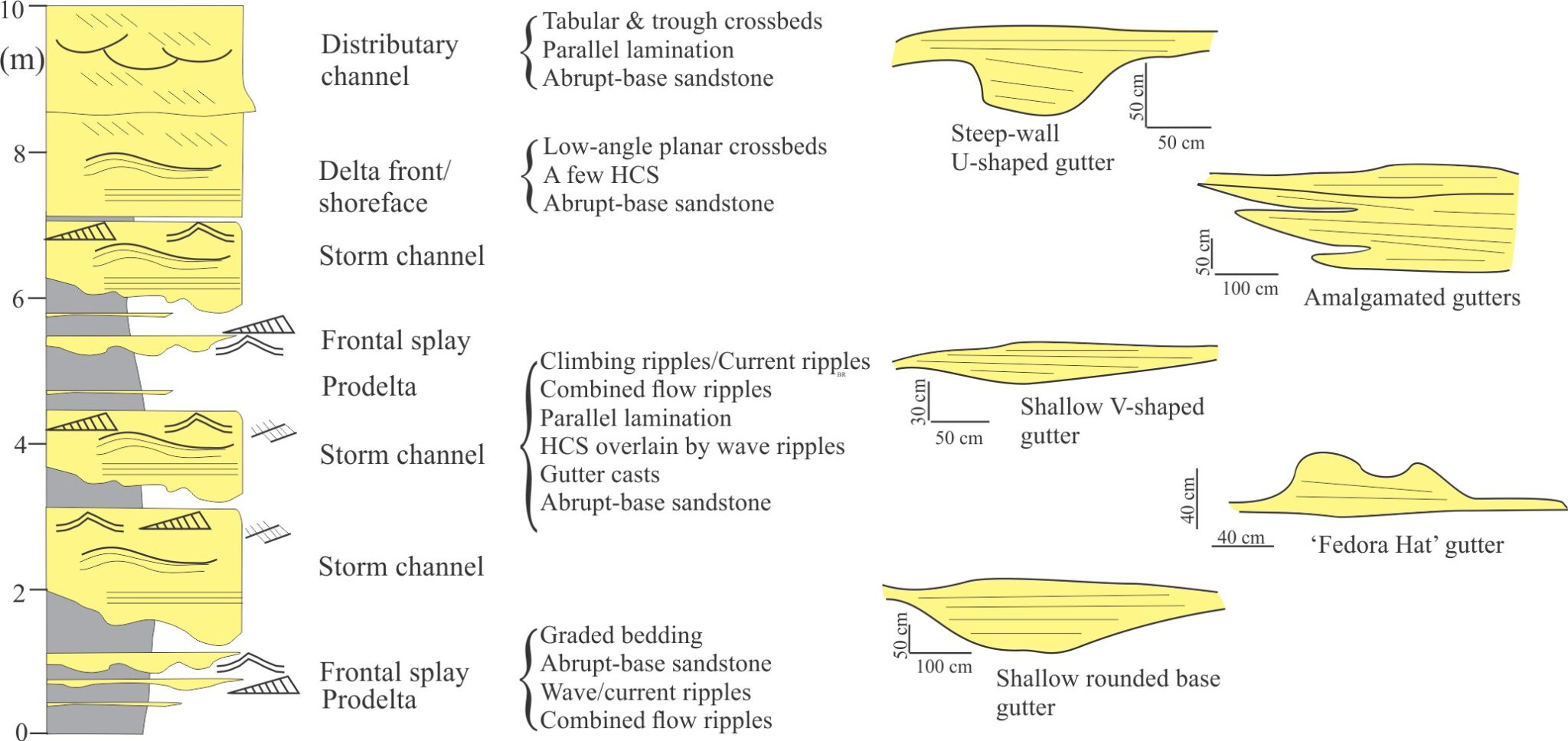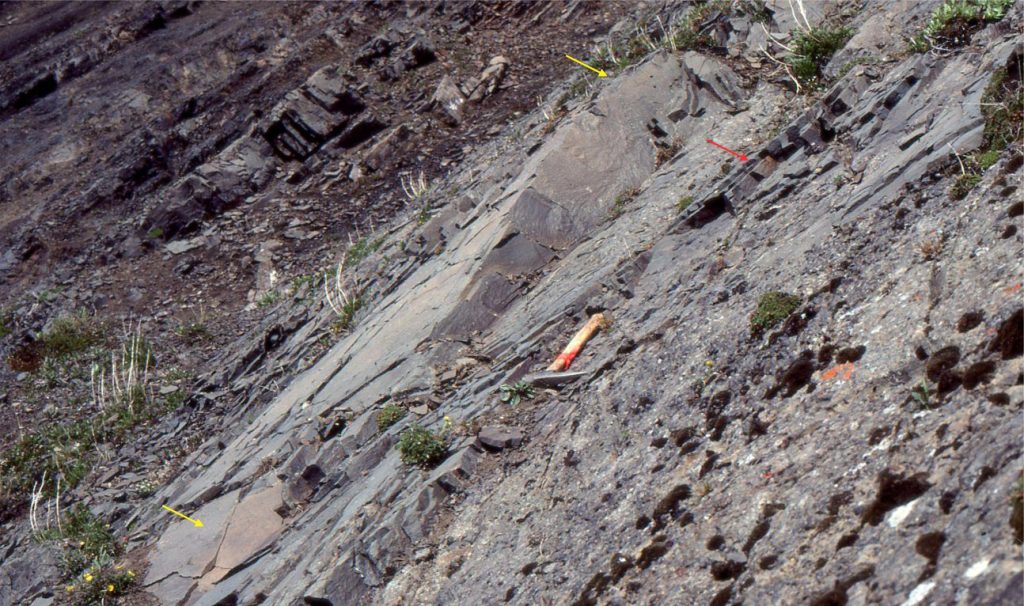
This is the third of three posts on tempestites:
The recognition of hummocky crossbeds by Harms et al., (1975) was an important moment on the time-line of stratigraphic discovery – it conferred empirical status to storm deposits in the rock record. No doubt there had been multiple observations of this bedform by many investigators prior to this publication, loosely described as “wavy lamination”, or “wavy, low-angle truncated laminae”, or “laminae conforming to truncated ripples”, but the significance of its relationship with “strong wave surges” or storm waves required Harms et al., astute theorizing. Decades later, hummocky cross-stratification (HCS) and subsequently swaley cross-stratification (SWS) have become the go-to sedimentary structures for recognition of major storm events in ancient shelf and delta successions.
Most of our knowledge of HCS as a lithofacies is derived from ancient examples, and a few flume experiments (e.g., Dumas and Arnott, 2006). We now know that there is significant variation in the internal stratification and external bedform of HCS. We also know that HCS-SWS are part of a suite of tempestite lithofacies and sedimentary structures that provide evidence for high energy, relatively short-lived events (tropical cyclones, typhoons, hurricanes):
- Scour surfaces, lag deposits
- Sole structures, including gutter casts.
- Density current, turbidite-like deposits.
- Other combined-flow bedforms such as modified climbing ripples.
- Surfaces that abruptly terminate bioturbation.
Much of our attention on tempestites has concentrated on continental shelves, particularly on the shoreface above storm wave-base. However, storms also influence the depositional and erosional record across environments like deltas, lagoons and tidal flats. In this case, one might expect to find tempestites associated with indicators of tidal currents and periodic exposure.
Two earlier articles on tempestites dealt with the basic forces that act on coastal water masses during storms (Coriolis forces, Ekman veering, Geostrophic flow), and the processes that act on the sediment-water interface to produce a stratigraphic record of these high-energy events – i.e., tempestites.
This post looks briefly at the lithofacies associated with tempestites, presented as diagrams that represent a kind of tempestite interpretation time-line over the last 5 decades. The time-line illustrates some of the changes in our collective thinking about HCS and tempestites as depositional events. I have taken some liberties with these diagrams, adding or subtracting information from the original published examples.
Tempestite lithofacies diagrams and models
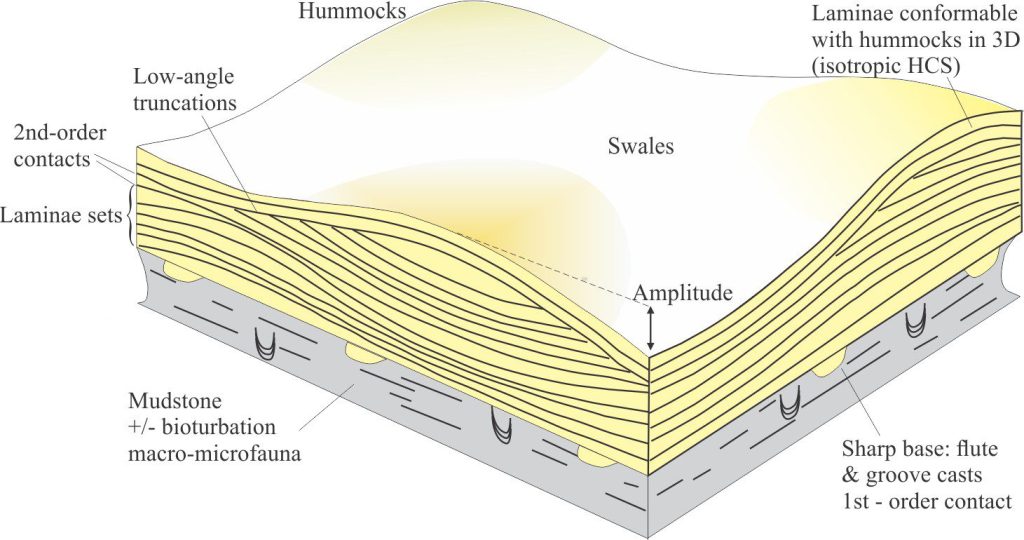
Harms et al., (1975) original diagram showed the basic 3D geometry of surface hummocks and the conforming laminae in 2D profiles. He noted that the laminae have similar geometries in profiles at any orientation, emphasizing the three-dimensionality of the hummocks and intervening swales, in contrast to angle of repose bedforms like tabular and trough crossbeds; this class of HCS is now referred to as isotropic. The diagram also shows truncation contacts between successive, stacked hummocks.
Dott and Bourgeois’ (1982) idealized column incorporates additional lithofacies and sedimentary structures that help a stratigrapher identify tempestites as high energy events:
- A basal erosion surface, with or without pebble, intraclast, or shell lags, that commonly preserves a variety of sole structures (e.g., flute and groove casts). The surface probably develops during the waxing stage of storm encroachment.
- A hierarchy of depositional and truncation surfaces within the main HCS unit.
- Angle of repose crossbeds that indicate a return to traction-dominated deposition.
- The succession may be capped by mudstone that contains varying degrees of bioturbation. Mud deposition and cultivation of the infaunal associations are predominantly post-storm.
- The abrupt, erosional surface capping the succession signals a new, high-energy event.
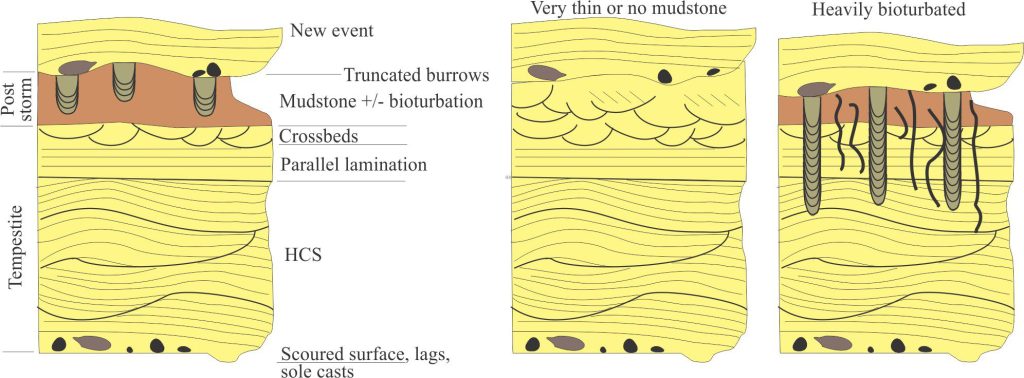
The debate over offshore-directed currents versus geostrophic currents received a boost with the paper by D. Leckie and L. Krystinik (1989). They collated paleocurrent data of tempestite-associated facies from several previously published examples, focusing on structures such as sole marks (flute, groove, and gutter casts), parting lineations, oriented wood, combined-flow ripples, and other indicators of slope orientation from HCS and turbidite-like lithofacies. The vector means for each data group were compared with shoreline orientations inferred from lithofacies (e.g., fairweather wave ripples) and paleogeography reconstruction. The data indicates a preponderance of shore-normal, offshore sediment transport, primarily via combined turbidity currents and storm wave oscillatory currents. Notwithstanding later discussions and critiques (e.g., Snedden and Swift, 1990), the Leckie and Krystinik paper continues to serve as a useful tempestite deposition model.
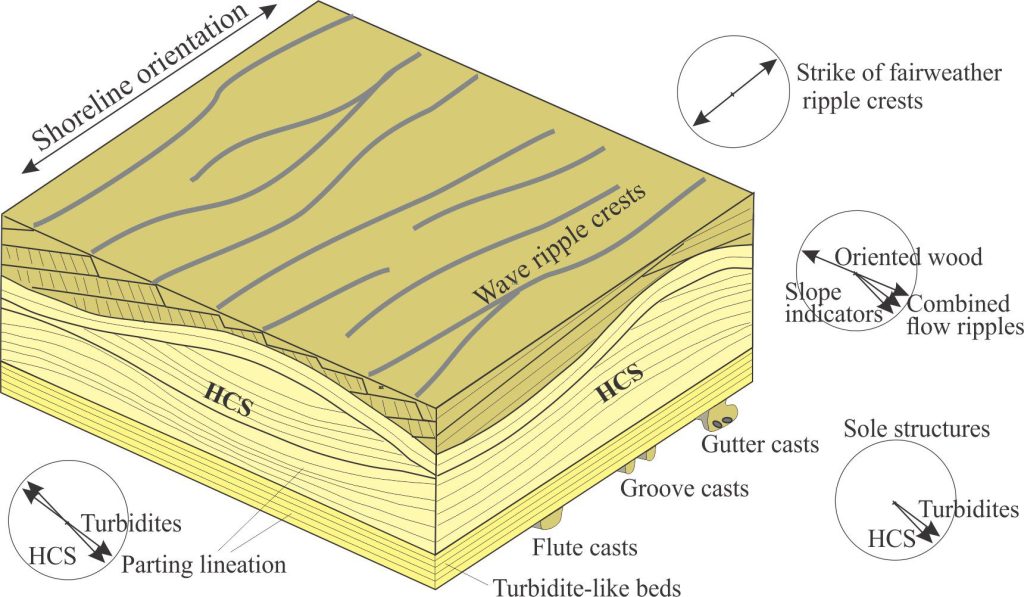
Duke et al., (1991) envisage coastal setup driven by refracted, shore-parallel storm waves that increase in power and period as the storm waxes. Return flow generates geostrophic currents that are oblique to the shoreline, currents that interact and combine with oscillatory flow moving sand in suspension and as bedload, depositing flat laminated sand beds (upper flow regime) and HCS. In this model, the strong shore-normal oscillatory flow combines with relatively weak shore-parallel to oblique geostrophic flow. Geostrophic flow extends over most of the shoreface which means that tempestite sand beds are widely distributed across the shelf. Oblique flow is documented by measuring sole structure and sand grain alignment azimuths. Duke et al., maintain that this combination of flow mechanisms is a better explanation for the shelf-wide distribution of tempestite deposits than shore-normal turbidity currents that have more localised distribution.
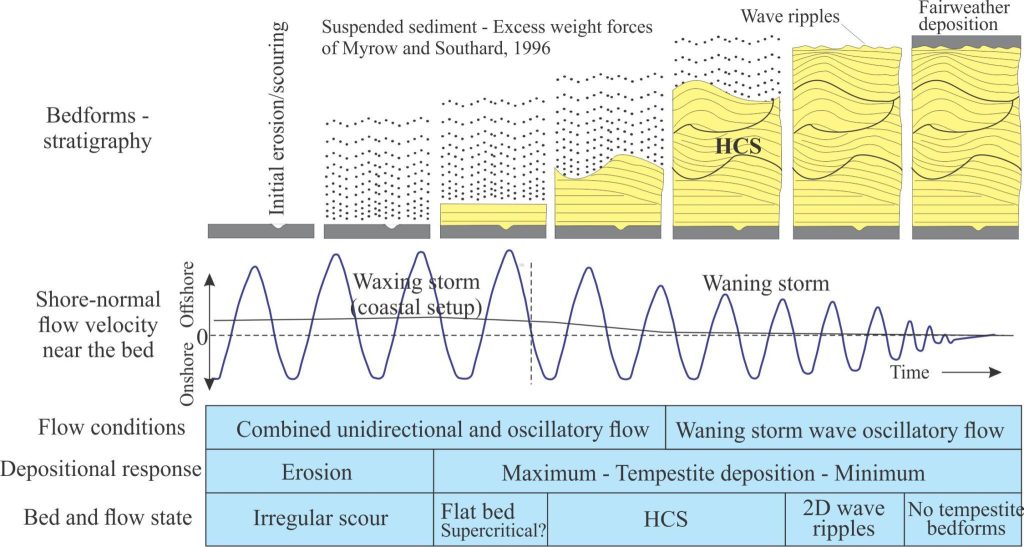
– Top panel: Lithofacies succession as the storm waxes and wanes. Flat, or plane-bed sand represents maximum shear stress across the sediment bed at the height of the storm, followed by deposition of HCS during combined geostrophic-wave oscillation flow. At a certain point during the waning stage, wave-orbital induced shear stress is not high enough to form combined flow hummocks – at this stage traction current wave bedforms are more likely to form.
– Center panel: The flow velocity profile at the sediment-water interface.
– Lower panel: Flow and bed conditions during the period of the storm.
The Myrow and Southard (1996) paper is still one of the best summaries of storm behaviour, flow conditions in the water column, sediment dispersal, and depositional products across continental shelves, acknowledging shore-parallel, shore-normal, and shore-oblique processes. They also introduce the concept of excess weight force, derived from sediment in suspension, as an important driver of sediment distribution across a shelf during storms (it is a function of density). They stress the importance of sole structures for determining the kinds of paleocurrents that can help distinguish between these three paleoflow directions. Their model diagram introduces a triangular plot that incorporates the most likely combinations of flow types at the sediment-water interface, emphasizing the broad range of sedimentary structures – bedforms, sole structures, and stratigraphic succession during a storm cycle.
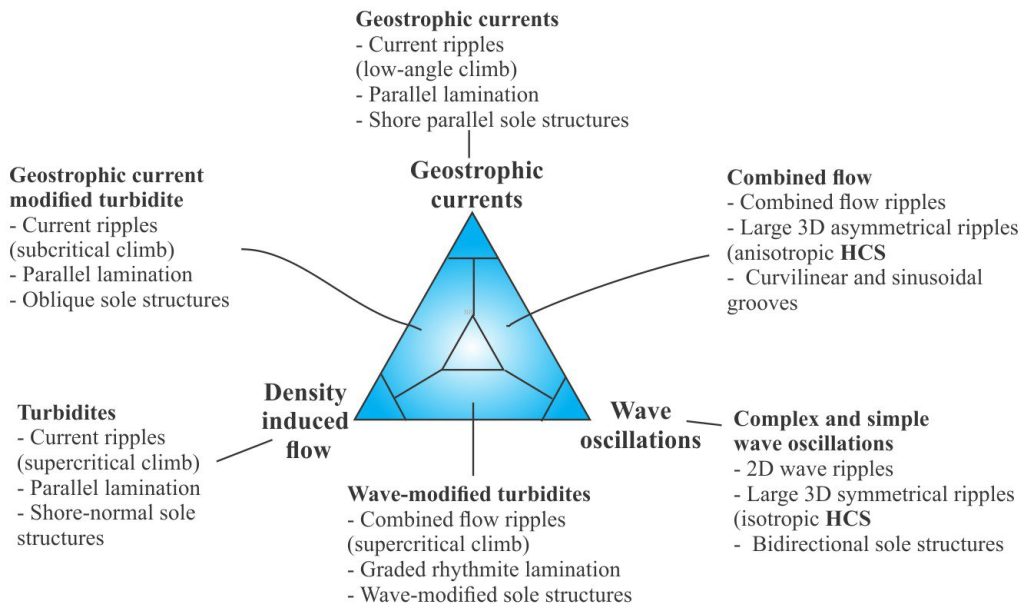
Myrow et al., (2002) revamp the ideal tempestite stratigraphic model to include wave modified turbidites, based on Lower Paleozoic shelf deposits exposed in the Antarctic Transantarctic Mountains. Theoretically the model can be applied to geostrophic or shore-normal turbidity currents. The combined flow components include HCS, upper plane bed parallel laminated, and climbing ripple lithofacies. Myrow et al., distinguish these wave-modified climbing ripples from current ripples by their sigmoidal, convex-up foresets – thus they are less likely to have formed by foreset grain avalanching.
A central part of their paper demonstrates the kind of lithofacies variability in offshore to nearshore environments influenced by storms (i.e., event beds), as well as the variability attendant on changing flow conditions during the progress of a storm. Some of these variations are shown below.
Paleocurrent data for the turbidite components includes ripples, parting lineations, and sole structures; the paleoslope was determined from slump fold vergence azimuths. In this model, the turbidity currents moved downslope, driven, at least partly, by excess weight forces generated by resuspension of shallow shoreface sediment by storm-waves and contributions from hyperpycnal flows.
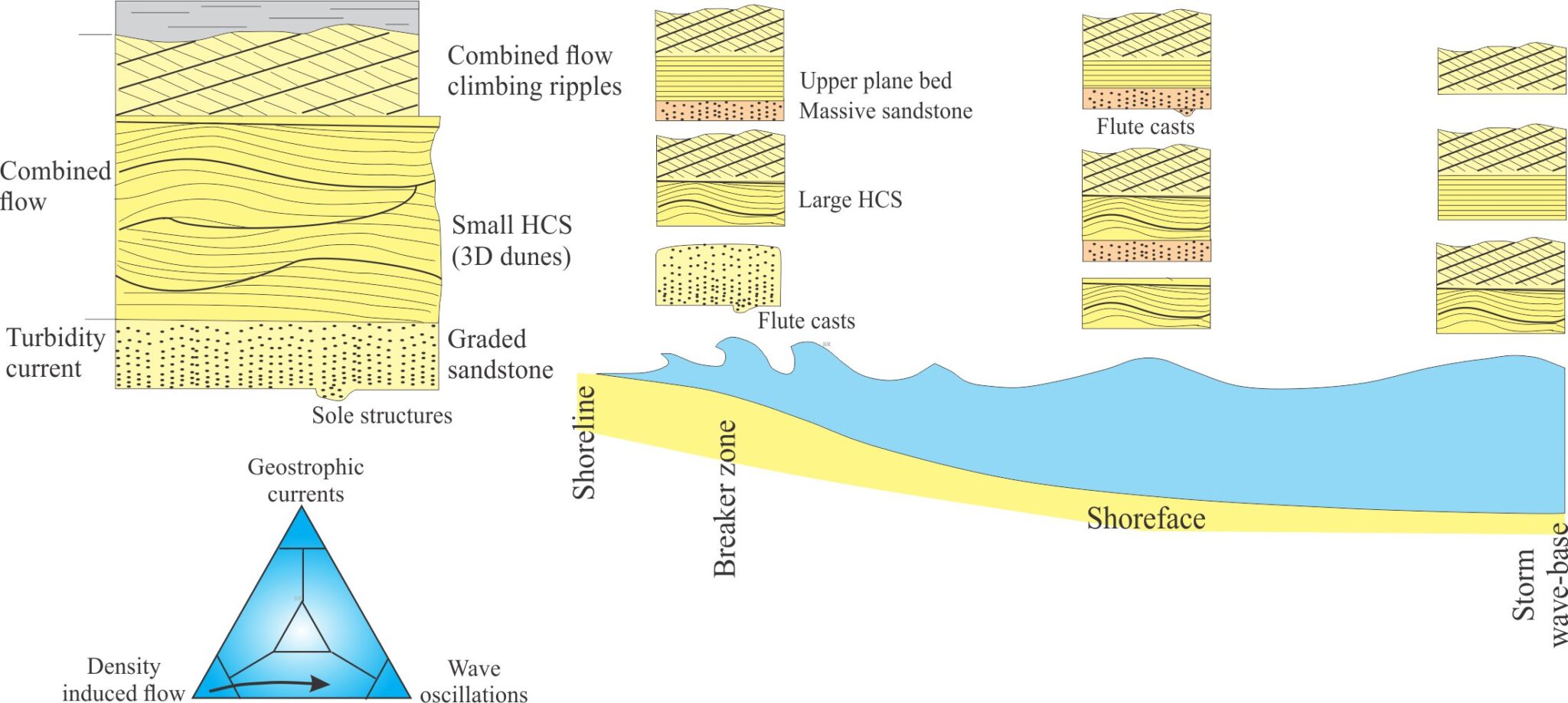
The Dumas and Arnott (2006) model is based on flume experiment observations of the sand-bed response to unidirectional and combined flow. This is an important contribution because it provides sorely needed empirical justification:
- The relative contributions of purely oscillatory flow versus combined unidirectional and oscillatory flows during the formation of HCS. They demonstrated that isotropic HCS could form under long period waves with moderate oscillatory flow velocities (0.5 to 0.9 m/s) and weak to no unidirectional flow.
- the relative positions of isotropic and anisotropic HCS and swaley bedding (SWS) across the shoreface – the optimal location is between fairweather and storm wave-base where unidirectional currents will be low enough to produce low-angle hummocky laminae.
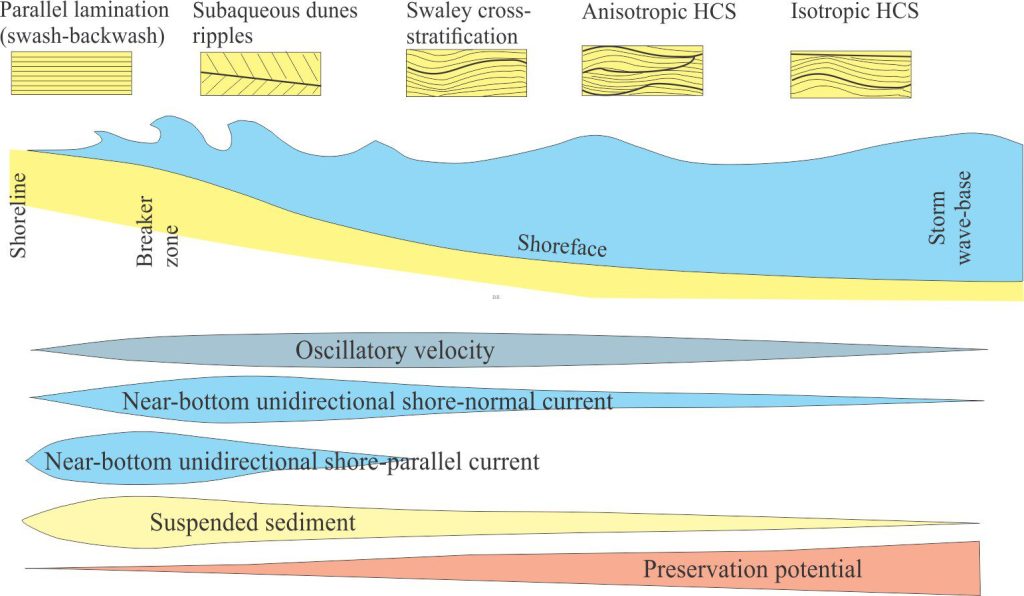
The tempestite model presented by Jelby et al., (2019) was teased from more than 600 storm event bed in the Lower Cretaceous Rurikfjellet Formation, Spitsbergen. Their model provides a good example of tempestite deposition on a storm-dominated prodelta ramp, where hyperpycnal flows formed offshore-directed, bottom-hugging density currents. An important part of the model also recognises the role of both steady and unsteady wave-generated oscillatory flows, summarized in a 3D triangular plot (a modified version of Myrow and Southard, 1996). They identify 6 basic lithofacies combinations that reflect the relative contributions of the different flow mechanisms – two of the more common lithofacies associations are shown below.
Steady versus unsteady oscillatory flow refers to the degree of continuity of wave periodicity and orbital velocity during the deposition of an event bed. Complex HCS is characterized by abrupt variations in laminae set contacts and thickness, that Jelby et al., interpret as the product of highly variable wave orbitals – perhaps reflecting rapid changes in wind direction, or interfering wave sets.
The lithofacies in this model include most of the bedforms and bioturbation observed in other models: isotropic and anisotropic HCS, combined flow climbing ripples, current and wave ripples, plane bed lamination, scour surfaces, sole structures, graded beds, and various kinds of soft-sediment deformation.
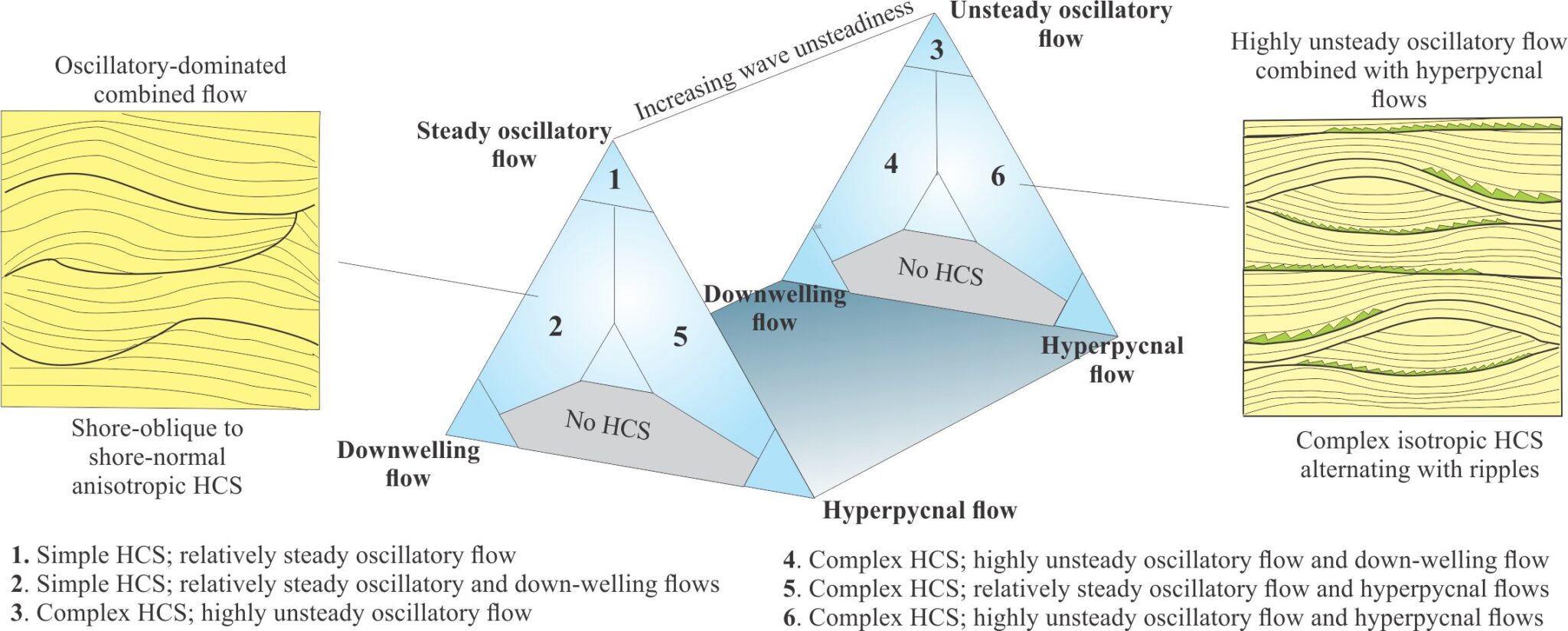
Rationalization of tempestite formation and stratigraphy over the last few decades has concentrated on modern and ancient shelf settings. However, there is increasing recognition that storms also play an important role in the shaping of deltas. The examples presented by Jelby et al., (2019, op cit.) and Vaucher et al., (2023, PDF available) are good illustrations of this role. Lin and Bhattacharya (2021, PDF available) have taken this a step further with their definition of a new class of delta – storm-flood-dominated deltas. Using the Late Cretaceous Gallup Formation as an example, they develop a model delta stratigraphy and diagrammatic reconstruction that incorporates the common tempestite structures, lithofacies, and bioturbation assemblages that are the storm-flood building blocks of delta lobes and prodeltas. The role of hyperpycnal and hypopycnal flows is paramount.
Gutter casts figure prominently in the Lin and Bhattacharya model. Sedimentary gutters are narrow, channel-like, scour-and-fill structures that are common in ancient shoreface and foreshore deposits but have also been reported in deep water successions. The shallow water varieties are commonly associated with storms, but they may also form during fairweather rip-current flow. Gutters can be straight or sinuous in plan-view, with highly variable profile shapes and sizes – widths from centimetres to metres. They are usually oriented normal to shorelines. They are important components of the storm-flood-dominated delta model because of their association with strong, focused, bottom-current flows, and their paleocurrent orientations.
